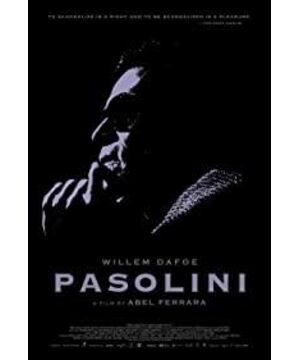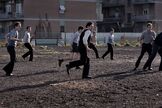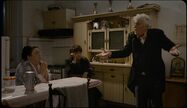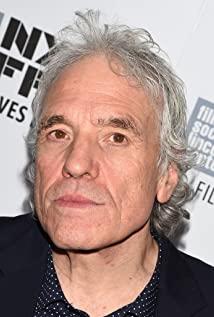In the history of film, it is not uncommon to put the perspective on the director himself to dig deeper into his personal creative state and inner world. In his masterpiece "Eight and a Half", Fellini turned the film into a form similar to psychological analysis, to express his creative confusion in the film business system-----he first Borrowing a scene of "people are trapped in cars and then fly out of the car window" to metaphorize the creative state of being trapped under the demands of investors, the expectations of the audience, and wanting to get rid of everything; then, the protagonist Flying into the sky, but always being held by the ankles with ropes by the people on the ground - a symbol of the status quo that cannot get rid of all this; at the same time, there is a shot of a "high tower" in the picture - the high tower is the film The scene at the end, where the protagonist is forced to commit suicide due to being unable to make a work that is far from his original intention, represents everything that suppresses his creative freedom. And after this rather commanding scene, Fellini begins to let his protagonist, who clearly symbolizes his own director, unfold a "representation of this scene"-the director living in In the hospital scene, the director is often in a room surrounded by dense black and white stripes to enhance the A kind of "uncomfortable pressure"); and during the filming of the film, the director continued to receive various commercialization requests from the filmmakers, inserting glamorous female stars, adding singing and dancing paragraphs, etc.; at the end of the shooting, the tower part , the director couldn't bear all of this, and thought that all the material he shot was rubbish, and committed suicide; then he was given a new life - part of Fellini's extreme desire to "get rid of all the limitations of the status quo and regain creative life". sustenance.
And back to this "Pasolini", for the same Italian artist as Fellini, the director of the film also tried to use Pasolini's literary and film works to explore Pasolini's worldview and The inner world - as Fellini did with the help of film in "Eight and a Half". As for Pasolini, the most obvious characteristics of him are the pursuit of same-sex love and a radical political outlook. In the film, the director wants to use Pasolini's creations to find the commonality and connection between the master's pursuit of eroticism and political views.
At the beginning of the film, the director used the scene of "The One Hundred and Twenty Days of Sodom" to show Pasolini's view of sex---penis and nudity fill the picture, direct and intense sexual display, representing Pasolini's exaltation of exposed and undisguised sexuality. As for Pasolini's view of sex, the film also made some direct expressions-in Pasolini's literary works, his characters, as male prostitutes, perform oral sex for the customers waiting in line one by one In the service, the director used a very straightforward fixed lens to film the whole process of his oral sex at close range and for a long time; and back to reality, Pasolini himself also has an explicit expression of courtship towards the male prostitute. In the paragraph of the restaurant, the director highlighted with close-up
The male prostitute devoured the meal to express a state of "undisguised desire"; and in the next film conceived by Pasolini, the protagonist and servants came to Sodom, a homosexual Hidden (in the station, the servants and the police are openly flirting), an open city with big sex as a festival (line: This is the freest city in the world; when the two just arrived at the train station, there is a close-up of a nude mural) , and the star symbolizing the "coming of the Messiah" adds a layer of "heaven" to the city of freedom. In the film, the director's expression of Pasolini's views on sex is relatively complete and smooth---he yearns for the freedom of sex, and admires the expression of undisguised and straightforward desires. For him, the freedom of sex is the Garden of Eden .
On the other hand, the director also can not ignore another part of Pasolini - the performance of political views. And the expression of this part just constitutes the biggest flaw in the quality of the film. We can see that in the first paragraph, the director tried to make some connection between the concept of sex and the concept of politics-after the screening of "One Hundred and Twenty Days of Sodom", Pasolini Introduced his creative ideas, "using sex to metaphorize politics", it can be seen that in the director's conception,
The concept of sexuality corresponds to Pasolini's political concept, and he yearns for a simple political ecology that is straightforward, exposed, and does not beat around the bush. Thus, in the expression of the film, Pasolini is actually a "simple and direct" person on which his views on sex and politics are based - at the screening of "Sodoma" After the end, the director cut into a scene of ancient Roman architecture, and the naked statues symbolized "direct and exposed", and then the ancient Roman council chamber shot from a distance magnified this "direct exposure" of shame at the physical level to the political level. : In ancient Rome in ancient times, people were not stingy with the naked self-display of the body, and the same state of politics, everything was straightforward; later, in Pasolini's literature, male prostitutes became politicians, in Pasolini's literature Compared to listening to his colleagues discussing politics in the contemporary social arena, he is more focused on listening to a story meeting - the man on the plane expresses his love to the flight attendant in a somewhat devious way ("I Can I treat you to dinner?”), then the plane crashed, first with the skeleton of the stewardess (symbolizing the destruction of implicit expressions of love), followed by the oncoming ancients (the return of ancient direct expressions of love); In addition, the record brought to him by Pasolini's sister (a straightforward woman who discusses chrysanthemums at the dinner table, and even the discomfort of the guests at the same table - the contrast between ancient sexual views and contemporary people) is Croatian. Traditional dance music (another symbol of the "early era"), and subsequent activities of Pasolini and male prostitutes, are also accompanied by the soundtrack of these dance music, symbolizing Pasolini's pursuit of an "ancient worldview" .
However, this pursuit of Pasolini is bound to fail in the contemporary era—it seriously violates contemporary morality and ethical consciousness. In the last part of the film, the director also clearly pointed out this fact: during the meal with the male prostitute, the two talked about the male prostitute's livelihood, and the male prostitute said "everything is for money", and then the picture cuts to the cooking Chef---even if this meal needs to be exchanged for money, this alludes to Pasolini's real relationship with male prostitutes based on money, Pasolini's pursuit of straightforward and pure sex is ultimately unrealizable; then, The two drove to the beach to have sex, and the director took the trouble to repeatedly shoot the bright and dark lighting in the car to show the instability of the future of their same-sex relationship; in the end, Pasolini seemed to escape even though he hid by the sea Rome, a city of serious modernization, but his homosexuality is still despised and suppressed by contemporary people - he died at the hands of anti-gay youth thugs.
As for the final destination of Pasolini's pursuit, at the end of the film, the director borrowed the film conceived by Pasolini to give the answer: the old man found the star where the Messiah came, and followed the star to "freedom" The city of Sodom, thus breaking away from the contemporary world (in the previous paragraphs of the home, the old man's wife repeatedly complained; A panoramic shot of a moaning wife in the living room separated by a partition", followed by a moving shot of an "old man who left chasing the stars, with his wife who was staying at home"), but the old man did not reach heaven in the end—they were communicating with each other. Stopping on the stairs to heaven, unable to move forward, the result is just a "wait a minute". The passage of the Stairway to Heaven is placed in parallel with Pasolini's corpse in reality, so that the state of the old man corresponds to Pasolini's own state---Pasolini living in contemporary times, after all, can't. Returning to ancient times to realize his own pursuit of freedom and straightforwardness (after the death paragraph, the ancient Roman council hall is cut again), but he is always willing to hold on to hope, to wait and wait for the day of heaven to come.
In the ending part of the film, the director did not let the work end in a "seemingly climax of movie viewing"---the stairs of the kingdom of heaven, but then joined a real life paragraph after Pasolini's death--- - The police investigation of his body, his sister and mother, and the notebook that eventually "recorded the invitation to the dinner he failed to make it to". From the perspective of emotional development, the latter paragraph seems to be a continuation of the dog's tail. But the director may be trying to use such a somewhat anti-climax design to emphasize the real world Pasolini is in—his family, the invitations he failed to go to, all constitute his pursuit The death of same-sex love is the damage and regret in real life, and everything in reality has become his concern and constraints on his complete flight, which is precisely the reason why he can't fly to heaven after all. In fact, in the movie, Pasolini in reality is somewhat repressed about his homosexuality - in the movie he conceived, the homosexual servants beside the old man are made by real and Pasolini. Played by the young man Solini eats and listens to Pasolini narrate the work, this is equivalent to a kind of inner suggestion from Pasolini: he has same-sex love for this friend, but because of his opposite sex Love orientation and a happy family (in the meal segment, the director shows his harmony with his wife and children, as well as Pasolini himself and his family's interaction), Pasolini cannot destroy his happiness, so he can only Putting one's love on the film work actually constitutes the suppression of Pasolini's pure freedom pursuit by real factors, and also corresponds to the ending of the film "returning to real life to show the damage caused by Pasolini's death". "The original intention of the design.
In this film, for the sex part, the director provides a relatively high degree of expression completion. Moreover, in terms of the way of expression, the director's ideas are not completely mediocre, but try to borrow Pasolini's own and a series of "Pasolini-style creations" shot by the director imitating Pasolini's style. , to dissect Pasolini's inner world. For a biographical film featuring a famous director, this is certainly a very fitting and relevant approach. However, as written at the beginning of this article, Pasolini himself, radical political views and straightforward sexual expression are two very important parts of him. Only when the two parts are combined and unified, is a world known to the world. Cognitive, more complete Pasolini. And in the film, the director did try to express Pasolini's radical and straightforward political views (such as using a crowbar to describe politics—a direct attack on contemporary politicians' social rhetoric, a direct attack on opposing political views) ), and wants to connect it with the concept of sexuality to form an expression of "Pasolini's pursuit of freedom and straightforwardness", so as to use Pasolini's ideal of life and worldview to summarize the concept of sexuality and politics.
However, in the film, there is still a huge gap between political views and sexual views. Except for Pasolini's self-report of "Sex represents politics" at the beginning, the two parts have never been well combined, and people clearly feel the switching back and forth between the two parts. In addition, in the independent expression part of political views, the director did not give a relatively smooth creation - Pasolini was just being interviewed, verbally narrating his political views, and reading some newspapers and reading various political events in contemporary times. All expressions of politics appear either obscure or confusing. The director just monotonously throws out some ominous oral lines, some bloody photo close-ups, some political words related to ideology such as "communism" and "fascism", without making a specific explanation of their meaning. Whether it is the expression of the political part as a separate chapter, or as a combination with the concept of sex, the completion of the film is not high enough. And because of this huge flaw, Pasolini presented in this film has also become an incomplete bust—a three-dimensional sexual personality and a vague political personality.
In fact, for the expression of politics, perhaps the biggest feature of the film - Pasolini's creation part can be borrowed. In Pasolini's novels, the protagonist is both a prostitute and a politician, and according to the stories he listens to, it can be seen that his yearning is ancient. The director is obviously borrowing this character to express the personal psychology of its creator Pasolini - he is an innuendo to Pasolini himself. Then, we can further increase the weight of this novel, to develop the story concretely, to express the life and feelings of the protagonist in the contemporary political arena, and to combine it with the secret work of male prostitutes and homosexual desires. In fact, the dry expression of Pasolini's political views in the film may come from the inconsistency of Pasolini's actual political activities, which caused the director to "don't know what to shoot"---he is not a politician, and his Political views are also mostly from oral or photographed works. As for the political life that Pasolini participated in, the director did not use it, perhaps due to the consideration of "not being artistic enough". Then, with the help of Pasolini's novel characters that allude to himself, this can be completely solved. Further, this novel has the potential to become the main part of the film, and the film can form the backbone through the three parts of "120 Days of Sodom", the novel, and the film work under consideration-- --This can not only become the film's tribute to Pasolini and its own characteristics, but also make the dry and jumping political expression in the real part concrete. However, in the finished film, only the final conception film really occupies more weight and plays a larger role in the ideology. However, the two previous works of creation seem to be relatively tasteless, staying at the level of superficiality.
In this regard, the director has a very good idea, but did not dig it deeply, and still focused on Pasolini himself, even if he could only express his political views dryly through dictation. In such a state, the Pasolini presented in this film can only show half of his face with a "sound view of sex and a chaotic view of politics".
View more about Pasolini reviews











